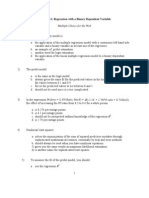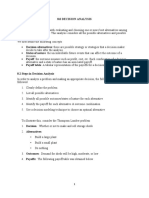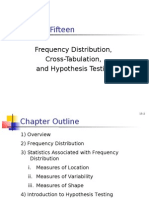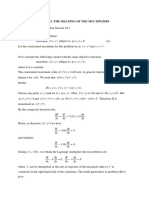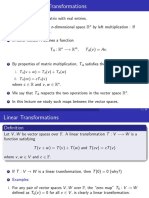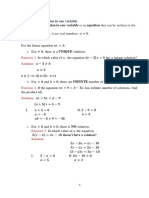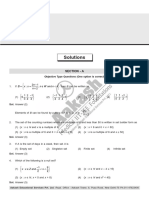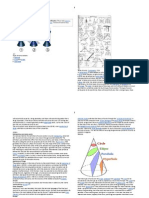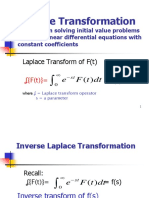Module 2 Review On Linear Equations and Inequalities
Uploaded by
Raphael GalitModule 2 Review On Linear Equations and Inequalities
Uploaded by
Raphael GalitModule 2: Review on Linear Equations & Linear Inequalities
Learning Outcomes
At the end of this module, you are expected to:
1. Solve linear equations in one or two variables
2. Compute the solution set of linear inequalities in one or two variables
3. Solve systems of linear equations and linear inequalities
2.1. Linear Equations in One Variable
A linear equation in one variable can be written in the form, 𝑎𝑥 + 𝑏 = 0 where a and b
are real numbers with 𝑎 ≠ 0. To solve an equation of this form is to find the value of variable x
that makes the statement true.
Transpose +4 to the right side of
Example: Solve 6𝑥 + 4 = 46
the equation, therefore, -4
Solution: 6𝑥 + 4 = 46
6𝑥 = 46 − 4 Subtract 4 to the right side then
6𝑥 = 42 divide both sides of the
equation by 6.
𝑥=7
If we substitute the computed value of x in the given equation, we have 46 = 46. Hence,
𝑥 = 7 is the solution of the equation.
Example: Solve 7𝑥 + 4 = 4(𝑥 + 7) Multiply 4 to (x+7)
Solution: 7𝑥 + 4 = 4(𝑥 + 7)
Move 4x to the left side of the equation
7𝑥 + 4 = 4𝑥 + 28
and 4 to the right side. Be mindful of the
7𝑥 − 4𝑥 = 28 − 4 change in their signs.
3𝑥 = 24
𝑥=8
Divide both sides of the equation by 3.
2.2. Linear Equations in Two Variables
A linear equation in two variables in in the form 𝑎𝑥 + 𝑏𝑦 = 𝑐, where a, b, and c are
constants and a and b ≠ 0. The solution of linear equation in two variables is the set of points on a
Management Science: Module 2 Page 1 of 10
line that satisfies the given equation. This can be done by assigning values for x and solving for
the corresponding values of y or by finding the intercept.
Example: Solve 5𝑥 + 3𝑦 = 15
Substitute 0 to the value of x
Solution: then proceed with the
Let x = 0 operation
5(0) + 3𝑦 = 15
3𝑦 = 15
𝑦=5
Substitute 0 to the value of y
Let y = 0 then proceed with the
5𝑥 + 3(0) = 15 operation
5𝑥 = 15
𝑥=3
Therefore, x-intercept is at (3,0) and y-intercept is at (0,5). Then, plotting the x and y
intercept on a Cartesian plane, we have:
Example: Solve 2𝑥 − 4 = 2𝑦 + 8
Solution:
Let x = 0
Substitute 0 to the value of x
2𝑥 − 4 = 2𝑦 + 8 then proceed with the
2(0) − 4 = 2𝑦 + 8 operation
−4 = 2𝑦 + 8
−2𝑦 = 8 + 4
−2𝑦 = 12
𝑦 = −6
Management Science: Module 2 Page 2 of 10
Let y = 0
2𝑥 − 4 = 2𝑦 + 8 Substitute 0 to the value of y
2𝑥 − 4 = 2(0) + 8 then proceed with the
2𝑥 − 4 = 0 + 8 operation
2𝑥 = 8 + 4
2𝑥 = 12
𝑥=6
Therefore, x-intercept is at (6,0) and y-intercept is at (0,-6). Then, plotting the x and y
intercept on a Cartesian plane, we have:
2.3. System of Linear Equations
A system of linear equations two or more linear equations with the same variable. The
solution of a system of linear equations is the point of intersection of the lines representing the
equations. This can be determined algebraically or graphically. The algebraic solution may be done
by elimination or substitution.
Example:
Solve: 2𝑥 + 𝑦 = 4 (equation 1)
𝑥 − 2𝑦 = 7 (equation 2)
Management Science: Module 2 Page 3 of 10
Solution: Multiply equation 1 by 2 so we
can eliminate the variable y via
2𝑥 + 𝑦 = 4 4𝑥 + 2𝑦 = 8 addition.
+ +
𝑥 − 2𝑦 = 7 𝑥 − 2𝑦 = 7
5𝑥 = 15
𝑥=3
Proceed with the operation.
You will get x=3. This will be
used to find the value of y.
To solve for the value of y, we will substitute 𝑥 = 3 to either equation 1 or equation 2.
Using equation 1:
2𝑥 + 𝑦 = 4
2(3) + 𝑦 = 4
6+𝑦 =4
𝑦 = 4−6
𝑦 = −2
Therefore, the point of intersection for the equations 2𝑥 + 𝑦 = 4 and 𝑥 − 2𝑦 = 7 is at point
(3, -2). This means that both equations will be true when (3, -2) is substituted in the equations.
2.4. Linear Inequalities in One Variable
An inequality is a statement formed by placing an inequality symbol between numeral and
variable expression. An inequality containing a variable is called an open sentence inequality. The
solution set of such inequality is the set of all values of the variables that make the inequality a
true statement.
Management Science: Module 2 Page 4 of 10
Just as with equations, we perform operation on inequalities that produce a simplified
equivalent inequality. We can perform essentially the same operation on inequalities that we
perform in equations. If we multiply and divide a negative integer to both sides of the inequality,
however, we have to reverse the order of the inequality symbol.
Example: Solve and graph 7𝑥 − 8 < 4𝑥 + 7
Solution:
Move 4x to the left side of the equation
and 8 to the right side.
7𝑥 − 8 < 4𝑥 + 7
Be mindful of the change in their signs.
7𝑥 − 4𝑥 < 7 + 8
3𝑥 < 15
𝑥<5
Divide both sides of the equation by 3.
This means that all values of x that is less than 5 will make the statement true. Try
substituting any values that is less than 5 to check.
The graph will look like this:
Example: Solve and graph 10𝑦 ≥ 4𝑦 + 6
Solution:
10𝑦 ≥ 4𝑦 + 6
Move 4y to the left side of the equation
10𝑦 − 4𝑦 ≥ 6
then proceed with the operation.
6𝑦 ≥ 6 Be mindful of the change in their signs.
𝑦≥1
Then, divide both sides of the equation by 6
Management Science: Module 2 Page 5 of 10
This means that all values of y that is greater than or equal to 1 will make the statement
true. Try substituting any values that is greater than or equal to 1 to check.
The graph will look like this:
2.5. Linear Inequalities in Two Variables
An inequality that can be written as: 𝐴𝑥 + 𝐵𝑦 < 𝐶, 𝐴𝑥 + 𝐵𝑦 > 𝐶, 𝐴𝑥 + 𝐵𝑦 ≤ 𝐶, and
𝐴𝑥 + 𝐵𝑦 ≥ 𝐶, where A, B, and C are real numbers and A and B are not both equal to zero (0), are
called linear inequalities in two variables.
The solution set of a linear inequality in two variables is the subset of the plane consisting
all points (x, y) whose coordinates satisfy the inequality.
To find the solution set of a linear inequality:
1) Replace the inequality symbol by an equal sign.
2) Graph the corresponding line. If the symbol of the inequality is < or >, use a dashed
line to indicate that the line is not part of the solution set.
3) Choose any point that does not lie on the line, if possible (0, 0), and substitute its
coordinate to the given inequality. If the point satisfies the inequality, all the points
on the same half-plane is the solution set of the inequality. Otherwise, the solution
is the half-plane not containing the test point.
Management Science: Module 2 Page 6 of 10
Example: Solve 3𝑥 + 2𝑦 ≤ 6
Solution:
3𝑥 + 2𝑦 ≤ 6
3𝑥 + 2𝑦 = 6
Upon solving, the x and y intercept are: (2, 0) and (0, 3). The graph will look like this:
Using the origin as a testing point,
3𝑥 + 2𝑦 ≤ 6
3(0) + 2(0) ≤ 6
0 ≤ 6 𝑇𝑅𝑈𝐸
We get a true statement; therefore, the solution set is the half-plane containing the origin.
Its graph will look like this:
Management Science: Module 2 Page 7 of 10
Try using any point found on the shaded area to test if the statement will be true.
1
Example: Solve 𝑥+𝑦 >4
2
Solution:
1
𝑥+𝑦 =4 or 𝑥 + 2𝑦 = 4
2
Upon solving, the x and y intercept are: (8, 0) and (0, 4). The graph will look like this:
Using the origin as a testing point,
1
𝑥+𝑦 > 4
2
1
(0) + 0 > 4
2
0 > 6 𝐹𝐴𝐿𝑆𝐸
We get a false statement; therefore, the solution set is the half-plane not containing the
origin. Its graph will look like this:
Management Science: Module 2 Page 8 of 10
2.6. System of Linear Inequalities
A combination of at least two inequalities in one or more variables which require a
simultaneous solution is called a system of inequalities. To solve a system of inequalities means
to find the ordered pairs which will satisfy all the conditions imposed on the variable. The solution
set is also known as the feasible region.
Example: Solve the system 𝑥 − 𝑦 ≤ 1 and 𝑥 + 𝑦 ≤ 3
Solution:
𝑥−𝑦 ≤1 : (1, 0)
(0, -1)
𝑥+𝑦 ≤3 : (3, 0)
(0, 3)
Graph of 𝑥 − 𝑦 ≤ 1
Graph of 𝑥 + 𝑦 ≤ 3
Management Science: Module 2 Page 9 of 10
When the two graphs are combined, their graphs will look like this:
Notice the area where the two graphs overlap? This is the feasible region. This means that
all the points located in that area will make the two inequalities true. Try to pick any point in that
area and substitute it to 𝑥 − 𝑦 ≤ 1 and 𝑥 + 𝑦 ≤ 3.
Management Science: Module 2 Page 10 of 10
You might also like
- Module 2 Part 1 - Types of Forecasting Models and Simple Linear RegressionNo ratings yetModule 2 Part 1 - Types of Forecasting Models and Simple Linear Regression71 pages
- Lecture Notes - Simple and Compound InterestNo ratings yetLecture Notes - Simple and Compound Interest20 pages
- 4.2 Relations, Functions, Domain & Range QuizNo ratings yet4.2 Relations, Functions, Domain & Range Quiz6 pages
- What-If Sensitivity Analysis For Linear ProgrammingNo ratings yetWhat-If Sensitivity Analysis For Linear Programming33 pages
- Module 1 Part 1 - Management Science and Its History - Qunatitative Analysis - Decision MakingNo ratings yetModule 1 Part 1 - Management Science and Its History - Qunatitative Analysis - Decision Making17 pages
- Scale of Measurement - Adekola KamaldeenNo ratings yetScale of Measurement - Adekola Kamaldeen5 pages
- Problems On Linear Programming Formulations - Aug - 2013100% (1)Problems On Linear Programming Formulations - Aug - 201316 pages
- Module 3 Part 1formulation of LP ProblemsNo ratings yetModule 3 Part 1formulation of LP Problems42 pages
- Critical Path Method Exercises: Based On The PMBOK® Guide Fifth EditionNo ratings yetCritical Path Method Exercises: Based On The PMBOK® Guide Fifth Edition8 pages
- Accounting - Answer Key Quiz - Financial Assets and Amortized CostNo ratings yetAccounting - Answer Key Quiz - Financial Assets and Amortized Cost3 pages
- Download Discrete mathematics for computing 2nd Edition Peter Grossman ebook All Chapters PDF100% (5)Download Discrete mathematics for computing 2nd Edition Peter Grossman ebook All Chapters PDF50 pages
- Lecture 11: Implicit Relations Reference: Pemberton & Rau Section 15.1 p295-298No ratings yetLecture 11: Implicit Relations Reference: Pemberton & Rau Section 15.1 p295-2982 pages
- Quantitative Techniques in Management - Set TheoryNo ratings yetQuantitative Techniques in Management - Set Theory20 pages
- Elementary Row Operations For Matrices Updated 2013 PDF0% (1)Elementary Row Operations For Matrices Updated 2013 PDF3 pages
- Obj. 4 Rational and Radical Equations (Presentation)100% (2)Obj. 4 Rational and Radical Equations (Presentation)18 pages
- Simplex Method For Standard Maximization ProblemNo ratings yetSimplex Method For Standard Maximization Problem6 pages
- Form Ax B, Where A, B Are Real Numbers. 0No ratings yetForm Ax B, Where A, B Are Real Numbers. 06 pages
- Course Title: Self-Defense (ARNIS) Course Code: P.E. 2No ratings yetCourse Title: Self-Defense (ARNIS) Course Code: P.E. 214 pages
- Module 1 Overview of Management ScienceNo ratings yetModule 1 Overview of Management Science10 pages
- Gabriel Nikolai L. Galit BS Accountancy 1ANo ratings yetGabriel Nikolai L. Galit BS Accountancy 1A1 page
- Statement of Cash Flows: Hyacinth Indira D. HipeNo ratings yetStatement of Cash Flows: Hyacinth Indira D. Hipe7 pages
- Conceptual Framework & Accounting: College of Business AdministrationNo ratings yetConceptual Framework & Accounting: College of Business Administration10 pages
- Crossword Puzzle On Points, Lines, & Linear EquationsNo ratings yetCrossword Puzzle On Points, Lines, & Linear Equations3 pages
- Applied Econometric Time Series 3Rd Ed.: Chapter 3: Modeling VolatilityNo ratings yetApplied Econometric Time Series 3Rd Ed.: Chapter 3: Modeling Volatility80 pages
- 10-Maths-Probability-Notes-Question-BankNo ratings yet10-Maths-Probability-Notes-Question-Bank17 pages
- Download Complete (Ebook) Pacemaker Geometry by Globe Fearon ISBN 9780130238375, 0130238376 PDF for All Chapters100% (4)Download Complete (Ebook) Pacemaker Geometry by Globe Fearon ISBN 9780130238375, 0130238376 PDF for All Chapters76 pages
- Abdullah Gül University ME 301 Machine Elements Group Project Fall 2020/2021No ratings yetAbdullah Gül University ME 301 Machine Elements Group Project Fall 2020/20218 pages
- 1.2 Quadratic Equations - Solves Equations Transformable To Quadratic Equations (Including Ratioal Algebraic Equations)0% (1)1.2 Quadratic Equations - Solves Equations Transformable To Quadratic Equations (Including Ratioal Algebraic Equations)16 pages
- Examples of Dynamic Programming ProblemsNo ratings yetExamples of Dynamic Programming Problems5 pages
- Date QQQQ Close Change Gain Avg Gain RS 14-Day RSINo ratings yetDate QQQQ Close Change Gain Avg Gain RS 14-Day RSI2 pages
- Module 2 Part 1 - Types of Forecasting Models and Simple Linear RegressionModule 2 Part 1 - Types of Forecasting Models and Simple Linear Regression
- What-If Sensitivity Analysis For Linear ProgrammingWhat-If Sensitivity Analysis For Linear Programming
- Module 1 Part 1 - Management Science and Its History - Qunatitative Analysis - Decision MakingModule 1 Part 1 - Management Science and Its History - Qunatitative Analysis - Decision Making
- Problems On Linear Programming Formulations - Aug - 2013Problems On Linear Programming Formulations - Aug - 2013
- Critical Path Method Exercises: Based On The PMBOK® Guide Fifth EditionCritical Path Method Exercises: Based On The PMBOK® Guide Fifth Edition
- Accounting - Answer Key Quiz - Financial Assets and Amortized CostAccounting - Answer Key Quiz - Financial Assets and Amortized Cost
- Download Discrete mathematics for computing 2nd Edition Peter Grossman ebook All Chapters PDFDownload Discrete mathematics for computing 2nd Edition Peter Grossman ebook All Chapters PDF
- Lecture 11: Implicit Relations Reference: Pemberton & Rau Section 15.1 p295-298Lecture 11: Implicit Relations Reference: Pemberton & Rau Section 15.1 p295-298
- Quantitative Techniques in Management - Set TheoryQuantitative Techniques in Management - Set Theory
- Elementary Row Operations For Matrices Updated 2013 PDFElementary Row Operations For Matrices Updated 2013 PDF
- Obj. 4 Rational and Radical Equations (Presentation)Obj. 4 Rational and Radical Equations (Presentation)
- Course Title: Self-Defense (ARNIS) Course Code: P.E. 2Course Title: Self-Defense (ARNIS) Course Code: P.E. 2
- Conceptual Framework & Accounting: College of Business AdministrationConceptual Framework & Accounting: College of Business Administration
- Crossword Puzzle On Points, Lines, & Linear EquationsCrossword Puzzle On Points, Lines, & Linear Equations
- Applied Econometric Time Series 3Rd Ed.: Chapter 3: Modeling VolatilityApplied Econometric Time Series 3Rd Ed.: Chapter 3: Modeling Volatility
- Download Complete (Ebook) Pacemaker Geometry by Globe Fearon ISBN 9780130238375, 0130238376 PDF for All ChaptersDownload Complete (Ebook) Pacemaker Geometry by Globe Fearon ISBN 9780130238375, 0130238376 PDF for All Chapters
- Abdullah Gül University ME 301 Machine Elements Group Project Fall 2020/2021Abdullah Gül University ME 301 Machine Elements Group Project Fall 2020/2021
- 1.2 Quadratic Equations - Solves Equations Transformable To Quadratic Equations (Including Ratioal Algebraic Equations)1.2 Quadratic Equations - Solves Equations Transformable To Quadratic Equations (Including Ratioal Algebraic Equations)
- Date QQQQ Close Change Gain Avg Gain RS 14-Day RSIDate QQQQ Close Change Gain Avg Gain RS 14-Day RSI












